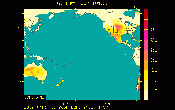The Meteorological Service of Singapore reports on 11 January 2000 for the South East Asian region: "The region remains under the influence of the northeast monsoon, bringing isolated showers of short duration over most ASEAN cities. The conditions are expected to persist for the next few days. The region remains clear of hot spots and smoke haze."
Fig. 1. Regional Surface Winds and Haze/Hot Spot Map,
11 January 2000
(Source: http://www.gov.sg/metsin/hazed.html)
Forecasts of winds and surface pressure are available at http://www.gov.sg/metsin/flm.html
The GFMC displays selected and daily updated global and Asia-Pacific Experimental Climate Prediction Center (ECPC) Fire Weather Forecasts (Fig.2-7). These examples allow a quicklook and provide daily and weekly total forecasts, and forecasted monthly anomalies (for next month). For background information refer to the ECPC products description page.
Fig. 2.-7. Fire Weather Index (FWI)
forecast for tomorrow (left), this week (center) and the predicted FWI anomaly for next
month (right) for the Western Pacific and the Pacific Ocean. The daily forecast usually
refers to 12:00 hrs noon UTC (Greenwich) time, but are currently not available; the weekly
total forecast and the monthly forecasted anomaly refer to 00:00 hrs UTC which is local
noon at dateline (180° longitude). Forecast time is 12:00 hrs noon UTC (Greenwich)
corresponding to local evening time in mainland and insular SE Asia (updated: 11
January 2000).
(Source: http://ecpc.ucsd.edu/m2s/m2s_ECPC_forecasts.html)
The ASEAN Haze Action Online provides the following information:
- Monitoring: Hyperlinks to institutions involved in regional monitoring and prediction of fire and smoke haze
- Haze News: ASEAN Transboundary Haze Update (updated daily)
- Intranet: Information and possible participation in the ASEAN Haze Action Online Intranet Information Services (for associated registered participants)
- Mobilization Plan: Model Fire Suppression Mobilization Plan
- Inventory: Inventory and analysis of forest and land fire suppression capabilities
- Haze Forum: Communication platform on fire and smoke-haze issues in the ASEAN region
- Calendar: Fire and haze-related events can be identified by a search modus
The ASEAN Fire Weather Information System (ASFWIS) is a co-operation between ASEAN and the Canadian Forest Service. It provides maps describing the current fire weather situation in South East Asia. This system is based upon the Canadian Forest Fire Danger Rating System (CFFDRS) (for further infomation to the CFFDRS refer to ASFWIS). Studies have shown that the CFFDRS is applicable outside of Canada. Currently it is also used in a modified form in New Zealand (see References). In New Zealand the Fire Weather Indices Fine Fuel Moisture Code (FFMC) and the Initial Spread Index (ISI) represent the fire danger in the scrublands. The Duff Moisture Code (DMC) is also applicable in South East Asia, because it potentially describes the moisture state of the upper peat layers in peat and peat swamp forests. All three parameters may serve as a suitable indicator of forest fire danger in South East Asia.
According to the ASFWIS for 11 January 2000 these parameters show various fire weather conditions over South East Asia.
 |
 |
 |
Fine Fuel Moisture Code |
Duff Moisture Code |
Drought Code |
 |
 |
|
Initial Spread Index |
Buildup Index |
Fire Weather Index |
Fig.8-13. Output maps of the ASFWIS, 11 January 2000 (update: 11 January 2000)
The Forest Fire Prevention and Control Project (FFPCP) in Palembang (Sumatra) reports no fire on 4 January 2000. Due to technical reasons there is no daily update of the IFFM (Samarinda, East Kalimantan) fire reports from Borneo Island.
Summary: Although the current fire weather conditions do under normal conditions not favour extensive land clearing by fire or escaping wildfires in Indonesia, the consequences of the large wildfires of 1997-98 must been taken into consideration. These fires had caused extensive degradation of primary and secondary forests along with the spreading of "alang-alang" (Imperata cylindrica) grasslands. These grasslands facilitate the spread of uncontrolled fires over large areas.
See also the IFFN Country Notes.





